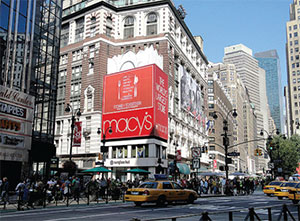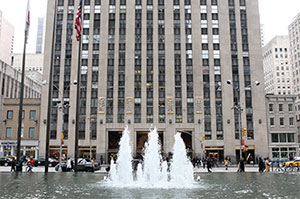Small property owners and New York City developers have been facing off since that adage about location in real estate was coined. And every once in a while, those contests of wills turn into lasting stalemates.
Manhattan is dotted with famed and not-so-famous locations where independent owners refused to sell. P.J. Clarke’s original restaurant at Third Avenue and 55th Street, and Smith & Wollensky a few blocks south at Third and 49th, are among the most celebrated, but there are any number of less remarkable properties where holdout owners refused the advances of deep-pocketed developers.
They may soon be joined by a new generation of holdouts spawned amid the recent land grab and development boom on the Far West Side.
“There are instances where the property owner doesn’t want to sell to the developer at any price. The property may be in the family for many generations and there is an emotional attachment,” said Jason Meister, broker and vice president at commercial brokerage Avison Young. There are also many cases where the property owner looks for a bigger payout than the developer is willing to offer, he added, and as a result, construction goes on around the holdout.
“What is most interesting about holdouts is how they gain their leverage. The battles over these holdouts have been set in many instances by zoning regulations that require large lot development,” Meister added. “As a result, small, well-located holdout lots become extremely valuable to a developer looking to maximize development.”
But still, some refuse to sell.
That was the case near Hudson Yards, with the Related Companies’ Abington House, the Robert A.M. Stern-designed, 320,000-square-foot apartment tower that covers almost all of the entire eastern end of its block between the High Line and 10th Avenue.
Almost all, that is, save for a roughly 8,000 square-foot walk-up at the corner of 29th Street and 10th Avenue. The property, with a retail storefront on street level and apartments above, has been owned for more than 40 years by members of the Lambros family.
Related’s partner on the project, Abington Properties, had since 1996 owned most of the parcels that made up the development site. The two exceptions were the Lambros’ plot on the corner and another fronting about 50 feet along 10th Avenue in the middle of the block.
Steve Ross’s firm was able to buy the mid-block parcel in 2006 for $10 million. But a spokesperson for Related said the Lambros family would not entertain a sale of their site, and by 2012 work had begun on the red-brick tower that would eventually rise 33 stories over its neighbor. Members of the Lambros family could not be reached for comment.
Today the small walk-up is oddly married to its neighbor. It is as tall as Abington House’s setback, and for a time, even hosted a sign advertising the rental office for Related’s property on its 29th Street facade.
Hard-core holdout
Just a block to the south, another property stands as a colorful reminder of West Chelsea’s not-too-distant history as one of Manhattan’s grittier neighborhoods.
In the middle of 28th Street, running block-through to 27th Street, Scores strip club sits squat and defiant between a new rental building and two buzzing construction sites. The property, at 526 West 28th Street, is owned by Scores owner Robert Gans.
To its immediate west, a team made up of Ekstein Development Partners, RD Management and L&M Development partners built a pair of mixed-use buildings on both ends of a block-through site. On the 28th Street side, the rental building, branded as +Art, climbs 13 stories in the air, rising well above its neighbor and sporting units that feature Sub-Zero appliances and rooftop cabanas.
On the 27th Street side stands a relatively modest five-story mixed-use apartment building, which the partners sold for $27.5 million in 2012. The new owner, Tavros Capital, was shopping a majority stake in the building earlier this year for $50 million.
To Scores’ immediate east, Harlan Berger’s Centaur Properties is building an 11-story, 96,000-square-foot mixed-use building on a block-through site the company bought in 2013 for $45 million. One lot closer to the High Line, Related is building its Zaha Hadid-designed condo.
Gans did not return calls seeking comment. Sources said he had been asking a premium for the property, which no developer appeared willing to meet.
Overplayed hand?
Further north in the greater Hudson Yards area, development is not as advanced as it is in West Chelsea, but holdouts are already starting to be conspicuous.
On West 38th Street between 10th and 11th avenues, for example, Weinberg Properties owns an oddly shaped lot wedged between the sunken Amtrak line running up the West Side, and a construction site. That site will soon be home to a 30-story rental building being developed by the Imperial Companies, a partnership between Michael Fascitelli, the ex-CEO of Vornado Realty Trust, and his former colleague at the REIT, Eric Birnbaum.
Weinberg bought the low-lying building, which runs block-through, in 1980 and rents it to a pair of auto body shops. A source said the company was approached by Imperial about selling, but turned down a substantial offer.
Both parties declined to comment.
That refusal may have been Weinberg’s last opportunity to get a true market offer for the property, which is subject to condemnation by the city to make way for the second leg of Hudson Park and Boulevard, the mid-block greenway, which is planned to run up to Times Square. While this spur is not yet completely funded, concerns that the site could be targeted in coming years for a park could hamper prospects for a future sale.
Legacy holdouts
Long before owners got balky on the Far West Side, these buildings defied development going on around them:
1) Macy’s ‘shopping bag’ – The Kaufman Organization owns a 5-story building at the corner of Broadway and 34th Street that Macy’s built its Herald Square flagship around in 1930. An amended 1948 lease running through 2021 shows Macy’s pays Kaufman $2.4 million per year to rent the property, which is wrapped in an ad for the store.
2) 30 Rock bookends – Two former townhouses hog the corners at either end of 30 Rockefeller Center along Sixth Avenue. Sol Goldman owned the building at the northern end of the block until 1970. The southern structure housed pubs until 1979, and is now home to an outpost of Magnolia Bakery.
3) P.J. Clarke’s – Tishman Realty built the 46-story skyscraper at 919 Third Avenue in the early 1970s, and the landmark eatery remains at the base of the building today at the corner of 56th Street.
4) Smith & Wollensky – The Durst Organization built the 29-story 805 Third Avenue in 1980, but this steakhouse still stands at the corner of 49th Street.
5) 567 Seventh Avenue – This four-story building is sandwiched in between a nearly 500,000 square foot office building and a 21-story tower near Times Square. The building last changed hands in 2013 for about $7.5 million, and now houses a bakery.


